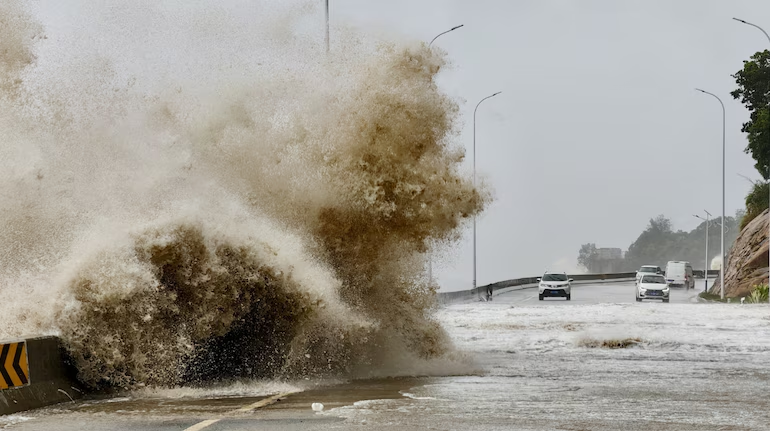When it comes to nature’s fury, Japan is no stranger. With its unique geography, the country frequently faces typhoons that test the resilience of its infrastructure and people. Ampil is the latest storm to challenge Japan, bringing with it a wave of disruptions and concern. This article dives deep into the impact of Ampil on the Tokyo area, focusing on the widespread cancellations and the steps taken to ensure public safety.
Ampil Disrupts Tokyo: A Storm on the Horizon
Imagine gearing up for a weekend getaway, only to find out your flight has been canceled. This was the reality for tens of thousands as Ampil loomed near Tokyo. The storm, with its powerful winds and torrential rains, prompted authorities to take precautionary measures, resulting in widespread cancellations of flights and trains in and around the Tokyo area.

Airports in a Frenzy: Mass Flight Cancellations
Tokyo’s bustling airports, Haneda and Narita, became the epicenter of disruption as dozens of flights were grounded. But the impact wasn’t just confined to Tokyo. Kansai, Osaka, and Chubu airports also felt the brunt of the storm, with cancellations affecting around 90,000 passengers. Whether people were heading out on business trips or vacations, their plans were abruptly halted by the storm’s unexpected shift.
Trains on Pause: Bullet Train Services Suspended
Japan’s famous Shinkansen bullet trains, known for their speed and efficiency, were also not immune to Ampil’s wrath. The Central Japan Railway took the precautionary step of halting all Shinkansen services between Tokyo and Nagoya for the entire day. Northeastern Japan’s bullet trains faced temporary suspensions, while some local Tokyo trains were either slowed down or canceled altogether.
Highway Closures: Roads Becoming Risk Zones
While the skies and tracks faced chaos, the roads were no better. Several highways in the Tokyo area were partially closed to traffic as authorities anticipated potential flooding and mudslides. The storm’s ferocity posed a real threat to drivers, leading to these necessary precautions to prevent accidents and ensure safety.
The Calm Before the Storm: Tokyo’s Preemptive Measures
Despite Tokyo remained eerily calm on the morning of the typhoon. The streets, usually packed with commuters and tourists, were sparse. The Bon summer holiday played a part in this, but the looming storm was the main reason for the deserted look of the city. People had either stayed indoors or moved up their travel plans to avoid getting caught in the storm’s path.
Ampil’s Strength: The Meteorological Perspective
So, how powerful was Ampil? According to the Japan Meteorological Agency, the storm sustained winds of 162 kph (101 mph) with even higher gusts. Moving north at 20 kph (12 mph), Ampil was forecasted to graze the waters near Tokyo in the evening before continuing its northward journey. Fortunately, it wasn’t expected to make landfall and was predicted to weaken into a tropical storm by Sunday.
Lessons from the Past: Japan’s Preparedness for Typhoons
Japan’s history with typhoons has made it a global leader in disaster preparedness. From early warning systems to efficient evacuation protocols, the country’s approach to dealing with natural disasters is a model for the world. Ampil is just another reminder of how crucial it is to stay prepared and vigilant.
Public Reaction: How the People of Tokyo Responded
The reaction of Tokyo’s residents was a mix of caution and resilience. Airports and train stations were packed a day before the storm, as people rushed to change their plans. By Friday morning, the city was drizzly and windy, but the overall atmosphere was one of calm acceptance. Stores remained open, though traffic was minimal.
Read More: Happy Independence Day 2024: Celebrating Freedom, Unity
After the Storm: What’s Next for Japan?
With Ampil expected to weaken, Japan can breathe a sigh of relief. However, the disruptions it caused serve as a stark reminder of the power of nature and the importance of staying prepared. As the country resumes its normal rhythm, the lessons learned from this storm will undoubtedly be applied to future typhoon preparations.
Final Thoughts: Reflecting on Ampil
In conclusion, Typhoon Ampil’s brush with Tokyo may not have been catastrophic, but it certainly was disruptive. From canceled flights to halted trains and closed highways, the storm’s impact was felt across the region. But as always, Japan’s preparedness and the resilience of its people shone through, ensuring that the damage was minimized and normalcy restored as quickly as possible.







